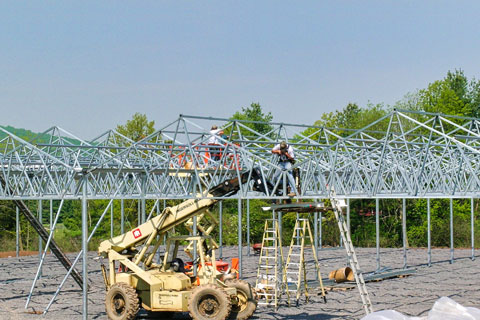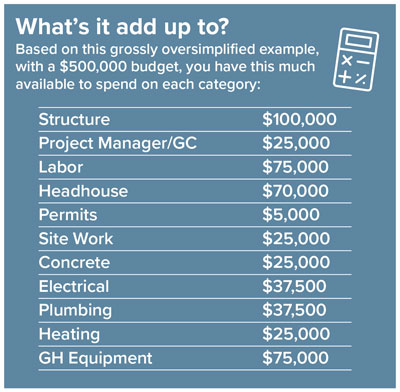4/1/2025
How Much Does a Greenhouse Project REALLY Cost?
Chris Beytes

Let’s say you’re a young grower ready to go it alone and start your own bedding plant business. You’ve acquired a piece of land and set aside some cash and arranged financing for your very first greenhouse and you’re ready to invest $500,000. You start shopping for structures, thinking that at roughly $10 per sq. ft. (a figure you got from the grower down the street), you can afford as much as an acre (about 44,000 sq. ft.) of greenhouse. Wow! A nice size for starting out!
But wait … haven’t you forgotten something? Or maybe a bunch of things? Like permits, engineering, site prep, gravel or asphalt, concrete, a well, plumbing, electrical, heating, environmental controls, energy curtains, a headhouse … even the labor to build it all?
Pictured: How much greenhouse can you afford? The answer is always “It depends,” but it’s safe to say that only about 20 to 25% of your budget will go towards the actual structure.
Anyone who’s completed a greenhouse project knows that a lot more goes into it than you might think. But how much, exactly, as a percentage of the total cost? We asked three experts—Paul Golden with Prospiant, Matt Stuppy with Stuppy Greenhouses and Jeff Warschauer with Rovero North America—to help us with the math. It was a challenge because every site and every project is unique, and their usual answer is, “It depends,” but we forced them to break it down into key components and what percent of the project each might be. The figures below are minimums you’ll need for each category; in some cases (like site work), it could be much higher.
The greenhouse structure: 20%
We told our experts we’re a new grower who wants to build a gutter-connected greenhouse, double-poly, with polycarbonate sidewalls, tallish, for a stable climate and equipment clearance, and natural ventilation. A production greenhouse, primarily for bedding and holiday pots. Those criteria leave plenty of engineering variables to meet building code requirements for northern snow loads, California earthquakes or Florida hurricanes, which can greatly impact cost.
Said Paul, “Typically, on a production range, the structure and covering is only 15% to 25% of the overall cost of the project, where it might be more like 40% to 50% of the cost of a retail project that has visual features that need to be engineered for permits.”
Plus, public spaces usually need to meet additional building code requirements.
Project management/General contractor: 5%
Are you handy? Many growers are and can serve as their own general contractor, saving 5% or more of a project’s cost. But not everyone is equipped for that and a slip-up by one trade can cost you tens of thousands, plus lost time. Often, hiring a pro to manage your project is well worth the cost.
“Depending on your level of expertise and how you want to spend your time, having the right person in charge is paramount to a successful project,” said Matt. “Don’t expect all of the companies you are working with to magically communicate and know what each is responsible to complete.”
Construction labor: 15%
Unless you’re specifying a turnkey project, the cost of a structure just lands a pile of steel, nuts and bolts on your property (oh, shipping is extra, too). Yes, you can put it up yourself (and some do, either when just starting out or after growing so large they have their own construction department), but most let the experts build it. Cost varies based on complexity of the project and includes many extras beyond just workers, said Jeff, including rental equipment like scissor lifts, temporary power and even portable toilets.
A headhouse: 14%
Can you operate without a headhouse (or production barn, as it’s often called)? Not for long. At the bare minimum you’ll want an office and weatherproof storage for inputs and chemicals. Matt said one rule of thumb for headhouse size versus greenhouse size is 10%, but Jeff said that no grower he’s built a project for has ever been satisfied with the amount of headhouse space they have—they always want more. He suggests 25% of your greenhouse size,“especially if you plan to expand in the future.”
Instead of a dedicated headhouse, one popular option is to allocate some greenhouse space as a production area. Grow baskets overhead and fill pots underneath.
Permits/engineering/soil tests etc.: 1%
It’s easy to overlook the reams of paperwork required by your local building department and their associated professional fees. While some areas don’t require permits for agricultural buildings, our experts know of cases in rural areas where growers have spent several years and tens of thousands of dollars on the permitting process, so check this carefully and budget accordingly.
Site work: 5%
Site preparation cost can vary widely and our experts were loath to include it in their figures. Flat land with good access and proper soil for building on? Easy. Hills, soft loam, rocks, lots of trees? Expensive. Also, do you want to prepare for Phase 2 now (always a wise decision)? Then there’s water runoff management and retention, gravel or asphalt for driveways. Extensive grading and excavation can easily cost more than your structure, said Paul. “A civil site review/plan and soil test are one of the first steps I recommend anyone building on a new site.”
Concrete: 5%
At the minimum, you’ll need concrete for column caissons and possibly sidewalks and knee walls. If you build a separate headhouse (and you should), it’ll need concrete footers/foundation and slab. The cost of concrete is going through the roof—in some places $200 per yard—so don’t be shocked by the bill.
Electrical: 7.5%
Assuming you have power at the street, you still need to get it to your greenhouse and headhouse. Jeff said electrical engineers will typically advise that you install a 480-volt three-phase service to accommodate larger motors on soil lines, irrigation pumps and vent motors. But even with a basic single-phase system to start out with, the more equipment you have, the more you’ll spend to wire it.
And what about a backup generator? It may seem like a luxury, but in reality it’s cheap insurance. A power-outage at a critical time could ruin your season.
Irrigation/plumbing: 7.5%
Do NOT skimp on your water! First, you need a well (unless you have access to abundant city or pond/lake water). Then water tests (from a neighbor’s well if you don’t yet have your own). And all the plumbing to get the water to the greenhouse. As for irrigation delivery, if you’re figuring on hoses only, you’re either stuck in the 1950s or are a glutton for punishment. At the minimum, you need overhead sprinklers, plus drip tubes for potted plants such as poinsettias. Also fertilizer injectors and a filtration system. And storage tanks for fertilizer. Also, advises Jeff, “Be sure to consider the expansion needs for Phase 2 and allow space for additional tanks and equipment.”
Heating: 5%
Even in the warmest climate, you’ll need at least some unit heaters to combat those rare-but-inevitable freezes. They’re not expensive, but you also need the structures from which to hang them and lines from your fuel source. The further north you go, the more capacity your heating system needs—which usually means hot water heat from boilers circulated throughout the greenhouse.
Equipment/growing systems: 15%
Possibly the biggest variable within the project is the equipment that goes inside your greenhouse: benches, exhaust and HAF fans, shade/energy curtains, environmental controls … not to mention soil-handling equipment, flat and/or pot fillers, and other labor- and time-saving tools (which aren’t necessarily part of this discussion, but which are helpful for running a profitable business). Even a low-tech greenhouse like a Quonset with unit heaters can potentially have 20% to 25% of its cost in equipment and growing systems, said Paul. In a high-tech produce or plug range, that number can grow to 40% or more.
 Now you can see that you really only have $100,000 to spend on the actual greenhouses structure—enough for perhaps 10,000 sq. ft. And that’s not enough space to make much money. A well-run, established greenhouse operation running year-round can gross about $20 per sq. ft. per year. A seasonal business, maybe only $7.50. Time to reset your expectations, your budget or both! Perhaps you can start with freestanding Quonset-style houses.
Now you can see that you really only have $100,000 to spend on the actual greenhouses structure—enough for perhaps 10,000 sq. ft. And that’s not enough space to make much money. A well-run, established greenhouse operation running year-round can gross about $20 per sq. ft. per year. A seasonal business, maybe only $7.50. Time to reset your expectations, your budget or both! Perhaps you can start with freestanding Quonset-style houses.
As Matt Stuppy advises, “Budget, budget, budget, plan, plan, plan.
“You want to finish the project and still have the personal energy and funds to start growing and—most importantly—selling plants,” he said. “Doing your project the right way from the beginning pays in the short and long term. Taking shortcuts and going cheap often leads to unplanned expenses as the project progresses and your team starts crop production.”
And, no matter what, think long-term, he added.
“If you can’t afford all the automation and growing systems in the beginning, make sure your design team has accounted for their addition in the future.” GT